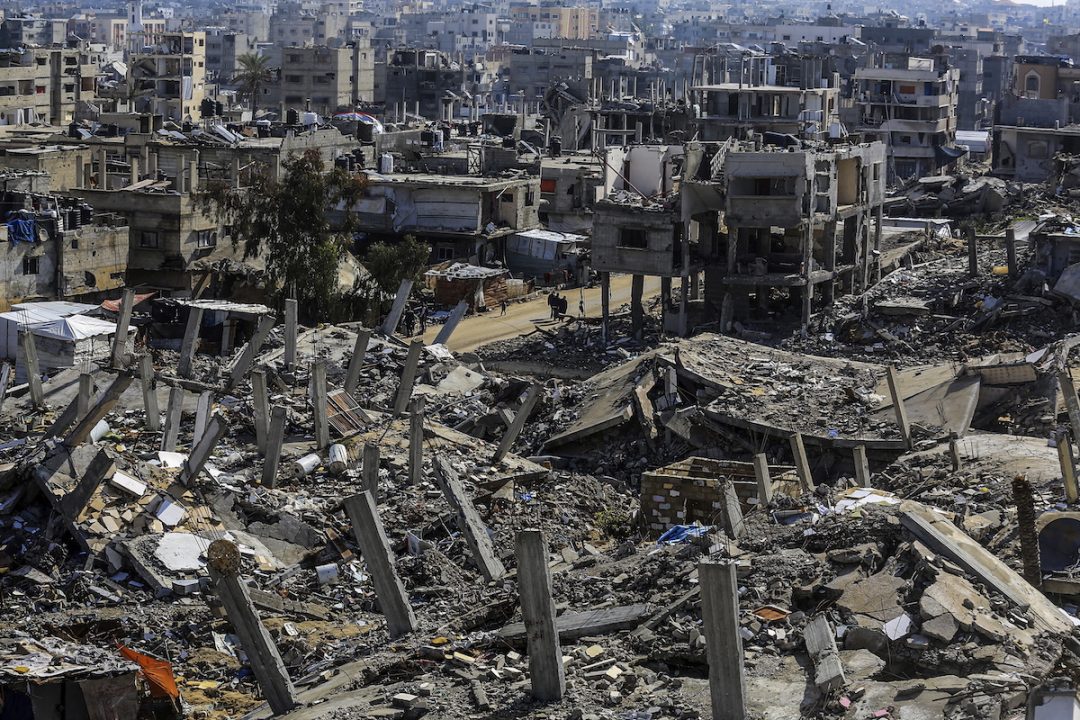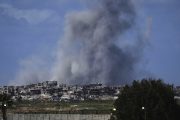
In a move risking escalating tensions in the Middle East, President Donald Trump has issued a stern ultimatum to Hamas. Speaking from the Oval Office on Monday, he demanded the release of all Israeli hostages held in Gaza by noon on Saturday. The president warned that failure to comply would lead to the cancellation of the existing ceasefire and an escalation of military action. Trump emphasized that if the hostages are not freed by the deadline, he would let “all hell break loose.” The president framed his threat as a personal opinion, insisting that the final decision lies with Israel. However, the weight of his words and their implications are impossible to ignore.
The president expressed doubt that Hamas would comply, saying, “A lot of the hostages are dead.” While some captives may have been executed or perished in captivity, another brutal reality looms over the situation: Between October 2023 and November 2024, Israel dropped more than 85,000 tons of bombs on Gaza — more explosives than were used in World War II.
How many hostages does Trump expect to be retrieved if “hell breaks loose” again? That remains an open question.
The Ceasefire Agreement
On January 15, after 15 months of war, Israel and Hamas agreed to a ceasefire. The negotiations were brokered by Qatar, Egypt, and the United States. The deal took effect on January 19. The three-phase deal aims to secure hostage releases, facilitate prisoner exchanges, increase humanitarian aid, and de-escalate military activity.
In the first phase, Hamas pledged to release 33 Israeli hostages, prioritizing women, children, the elderly, and female soldiers. If fewer than 33 are alive, the remains of deceased captives should be returned. In exchange, Israel agreed to release 1,904 Palestinian prisoners, including 737 serving life sentences. The deal also provides for 600 daily humanitarian aid trucks. Half of them are designated for northern Gaza, which has been hit hardest. At the same time, Israel agreed to scale down military operations, withdraw from key urban areas, and limit aerial surveillance for up to 12 hours daily. Israel also agreed to allow displaced Palestinians to return home.
The second — pending — phase requires Hamas to release all remaining living Israeli hostages. That includes men and military personnel. Israel agreed to release additional prisoners. This stage depends on both sides committing to “sustainable calm” and Israel completing its withdrawal from Gaza.
The final phase focuses on exchanging the remains of deceased hostages and prisoners. Israel is expected to lift its blockade on Gaza, provided Hamas does not rebuild its military capabilities. Reconstruction efforts will then move forward with support from international aid.
The agreement is overseen by Egypt, Qatar, and the United Nations (UN), with the United States acting as a guarantor.
Hamas Accusations
On Monday, Hamas accused Israel of breaching the ceasefire and announced it would halt further hostage releases “until further notice.” The group claims Israel has failed to uphold key terms of the truce.
Over the last few days, Hamas officials cited three major violations:
- Blocking the return of displaced Palestinians: Israel allegedly stalled the agreed-upon return of thousands of displaced residents to northern Gaza.
- Ongoing military operations: Israeli forces have reportedly killed at least 25 Palestinians and wounded dozens since January 20.
- Restricting humanitarian aid: Israel is hindering entry of tents, fuel, and heavy machinery, despite provisions allowing 600 aid trucks daily.
Adding to the dispute, Hamas challenged the U.S. role as a ceasefire guarantor, citing Trump’s proposal to permanently displace Palestinians from Gaza. Mediators postponed negotiations, awaiting clarity from Washington.
Hamas has also warned that Trump’s vision for Gaza — which includes blocking the return of displaced Palestinians and effectively occupying the enclave — could jeopardize the entire ceasefire deal.
Israel’s Response
In response to Hamas’s accusations, Israeli officials have asserted that they are committed to the terms of the ceasefire. They have accused Hamas of violating the agreement by delaying the release of hostages. Israeli Defense Minister Israel Katz stated that Hamas’s announcement to suspend hostage releases constitutes a “complete violation” of the agreement.
Prime Minister Benjamin Netanyahu has indicated that Israel is prepared to resume military operations. According to The Times of Israel, “Netanyahu has in recent days kept the door open to resuming fighting with Hamas rather than continuing to a second phase of the deal.”
Hostages and Prisoners
As of last Saturday, an estimated 76 Israeli hostages remain in Hamas captivity. Forty-two of them are presumed alive.
As of last October, more than 10,100 Palestinian prisoners were reportedly held in Israeli jails. That included 3,398 people under administrative detention — meaning they were imprisoned without formal charges or trial.
Since the start of the ceasefire negotiations, prisoner exchanges have taken place. Most recently, on February 8, Israel released 183 Palestinian prisoners, including 18 serving life sentences, as part of a deal to secure the freedom of Israeli hostages.
At the same time, Hamas has released a total of 138 hostages. This includes 105 individuals freed during a 2023 prisoner-exchange deal. Additionally, four hostages were released unilaterally by Hamas. The Israel Defense Forces (IDF) rescued eight hostages in separate operations. In 2025, 21 more hostages were released as part of a new prisoner exchange deal.
Broader Context
Trump’s ultimatum comes just weeks after his administration lifted a hold on the delivery of 2,000-pound bombs to Israel, a decision that had been paused by the Biden administration due to concerns over civilian casualties in Gaza. The shipment, which includes approximately 1,800 Mark 84 bombs, was released in January.
With this latest move, Trump appears less interested in maintaining the ceasefire and more in pushing Netanyahu toward an all-out offensive. Last week, Trump made it clear he wants Netanyahu to “finish the job.” During the Israeli prime minister’s visit to Washington, Trump unveiled has rather grand plans for Gaza once the dust settles. Namely, he wants to “own it” and turn it into the “Middle East Riviera.” In a Fox News interview aired Monday, he stressed that the displaced Palestinian population would have no right to return.
Trump’s proposal was widely condemned as ethnic cleansing. Both allies and adversaries rejected it, instead reaffirming support for a two-state solution. Critics also argue that despite Israel’s 2005 withdrawal, its blockade and military control over Gaza amount to an ongoing occupation.
Related:
Trump: U.S. to “Own” and Rebuild Gaza, Displace Its People
IDF to Oversee Gaza Cleansing; White House Calls It “Temporary”





